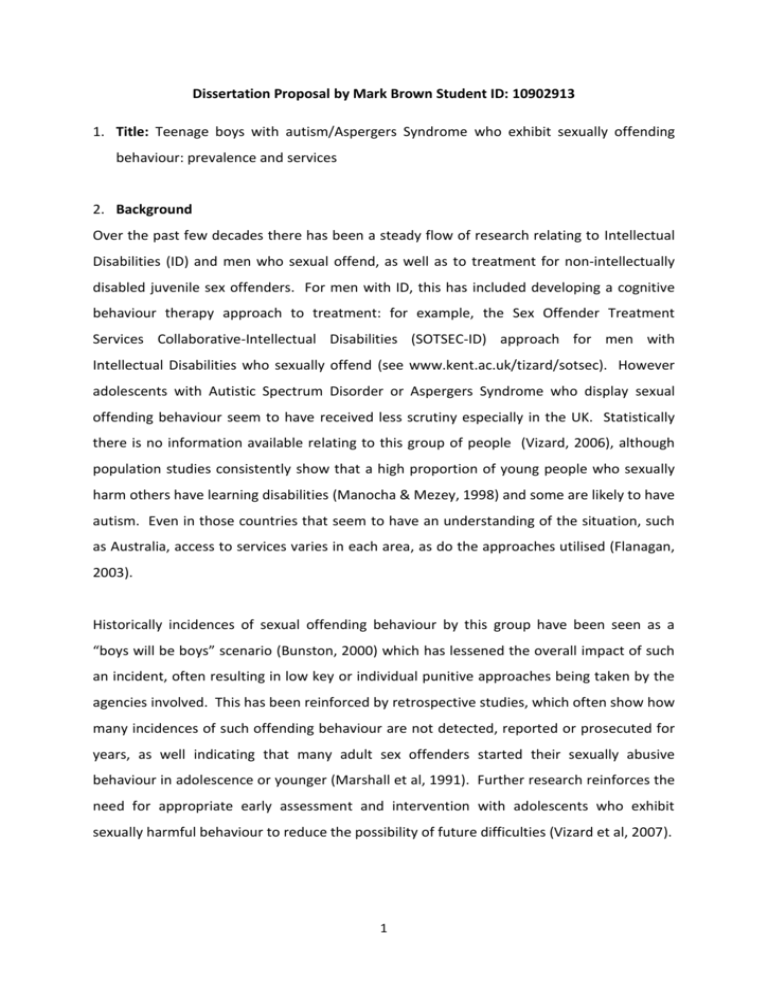
Dissertation Proposal by Mark Brown Student ID: 10902913
1. Title: Teenage boys with autism/Aspergers Syndrome who exhibit sexually offending
behaviour: prevalence and services
2. Background
Over the past few decades there has been a steady flow of research relating to Intellectual
Disabilities (ID) and men who sexual offend, as well as to treatment for non-intellectually
disabled juvenile sex offenders. For men with ID, this has included developing a cognitive
behaviour therapy approach to treatment: for example, the Sex Offender Treatment
Services Collaborative-Intellectual Disabilities (SOTSEC-ID) approach for men with
Intellectual Disabilities who sexually offend (see www.kent.ac.uk/tizard/sotsec). However
adolescents with Autistic Spectrum Disorder or Aspergers Syndrome who display sexual
offending behaviour seem to have received less scrutiny especially in the UK. Statistically
there is no information available relating to this group of people (Vizard, 2006), although
population studies consistently show that a high proportion of young people who sexually
harm others have learning disabilities (Manocha & Mezey, 1998) and some are likely to have
autism. Even in those countries that seem to have an understanding of the situation, such
as Australia, access to services varies in each area, as do the approaches utilised (Flanagan,
2003).
Historically incidences of sexual offending behaviour by this group have been seen as a
“boys will be boys” scenario (Bunston, 2000) which has lessened the overall impact of such
an incident, often resulting in low key or individual punitive approaches being taken by the
agencies involved. This has been reinforced by retrospective studies, which often show how
many incidences of such offending behaviour are not detected, reported or prosecuted for
years, as well indicating that many adult sex offenders started their sexually abusive
behaviour in adolescence or younger (Marshall et al, 1991). Further research reinforces the
need for appropriate early assessment and intervention with adolescents who exhibit
sexually harmful behaviour to reduce the possibility of future difficulties (Vizard et al, 2007).
1
During my own work I have helped facilitate a SOTSEC-ID (Adult) Men’s Group during which
frequent stories were told by the participants about their childhood experiences of being
abused and also being the abuser. Furthermore, working with a number of adolescents who
have exhibited some form of inappropriate sexualised behaviour has shown knee jerk
reactions by services, often resulting in the perpetrator being excluded from school for a
few days and their records being adjusted accordingly. Upon their return to school, staff
“escort” the adolescent wherever they go until it is deemed appropriate to phase out, but
very little is done to ascertain and understand underlying reasons for behaviour. Thus the
situation returns to its previous state until next time.
3. Purpose of Project
The purpose of the project will be to identify the occurrence of sexually harmful behaviour
exhibited by pupils within autistic specific schools. Also to review the approaches and
services used following such incidents, including any relapses in behaviour.
4. Method
Methodology will involve a survey of specialist schools for children with
autism/Aspergers Syndrome
Staff will be asked to provide anonymised details on teenagers with
autism/Aspergers Syndrome who have exhibited sexual offending behaviour.
Staff will also be asked to detail the approaches and services used for these
teenagers.
Initially the schools included will comprise of six run by the National Autistic Society
(NAS) providing for approximately 600 pupils, this sample will be widened depending
upon the response.
Information will be gathered via a questionnaire devised specifically for the project
examining the school population and data relating to incidents of inappropriate
sexualised behaviour. Consent will not be required from alleged perpetrators or
victims because the date gathered will be anonymous, but consent will be gained
from the person completing the questionnaire (normally the head teacher). The
resulting data will be analysed using the SPSS software.
2
5. Dissemination
Dissemination of results will be to all participating schools and the NAS via written
summary. Additional dissemination will be achieved via potential publication of the results
in appropriate journals such as Journal of Applied Research in Intellectual Disabilities.
6. Timetable
Distribute questionnaire to the initial six school– Beginning February 2011
Collect and collate questionnaires from the schools – Mid March 2011
Distribute additional questionnaires to other identified schools if required – April
2011
Collect questionnaires from the schools – May 2011
Collate information and write up draft paper – October 2011
Complete final paper and disseminate results – February 2012
7. References
Bunston, W. (2000) Working with Adolescents and Children Who Have Committed
Sex Offences A.N.Z.J Family Therapy, 21, 1, 1-7
Flanagan, K. (2003) Intervention with sexually abusive young people in Australia and
New Zealand. Journal of Sexual Aggression 9, 2, 135-149
Manocha, K., & Mezey, G. (1998) British Adolescents Who Sexually Abuse: A
Descriptive Study. The Journal of Forensic Psychiatry 3, 588-608
Marshall, W.L., Barbaree, H.E., & Eccles, A. (1991) Early onset and deviant sexuality
in child molesters. Journal of Interpersonal Violence, 6, 323-336
Vizard, E. (2006) Sexually Abusive Behaviour by Children and Adolescents. Child and
Adolescent Mental Health Vol 11,No 1, 2-8
Vizard, E., Hickey, N., McCrory, E. (2007) Developmental trajectories associated with
juvenile sexually abusive behaviour and emerging severe personality disorder in
childhood: 3-year study. British Journal of Psychiatry 190, 27-32
3







